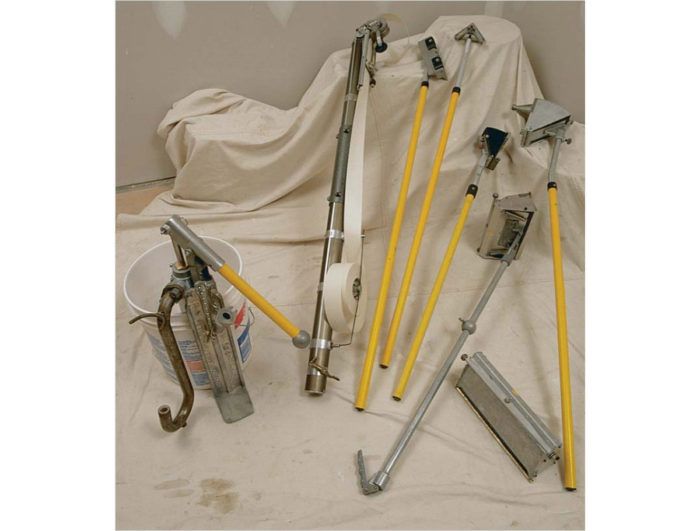Mechanical Drywall Tools
This family of specialized taping and finishing tools allows you to do a faster, more precise job.

Synopsis: A professional drywall finisher provides an overview of specialized drywall tools, such as automatic tapers, corner rollers, finishing boxes, and nail spotters, and brief instructions on how they are used. Included is a sidebar on the banjo taping tool, a simpler and inexpensive alternative to an automatic taper, and a list of sources.
In my prime I could tape and finish an average of 8,000 sq. ft. of drywall (about 170 4×12 sheets) in four days by myself with a set of mechanical drywall tools. Now I work at a slower pace, but I still can complete about 12,000 sq. ft. in a week with the help of one of my brothers.
If you don’t tape and finish a lot of drywall, you may be content doing it the old-fashioned way with a pan, a knife and a roll of tape. But if you do a lot of drywall or just like to try new things, I suggest you give mechanical tools a try.
There’s a whole family of mechanical drywall tools to take you from tape to finish. Heading this group is the automatic taper, often referred to by the trade name Bazooka, which is made by Ames Taping Tool Systems Company. The taper is an impressive thing to see in action. As its wheels move along the drywall, the device slathers a metered amount of joint compound onto the tape and pastes the tape to the wall. At the end of the joint, I stop and pull the handle, which is connected to a built-in blade that cuts the tape to length. In experienced hands, the automatic taper leaves old fashioned hand tools behind in its wake.
There’s a mechanical tool for most drywall applications
Drywall finishing is a series of procedures: taping joints, filling recesses, floating butt joints and finish coating. Most of what can be done with hand tools also can be done with automatic tools.
If I were using hand tools to tape drywall joints, I’d start with a roll of tape, a knife and a pan of joint compound. I would fill the joint with a bedding coat, stretch tape along the joint and then smooth it with a drywall knife. After that coat dried, I’d go over the taped joint with two successive coats of compound, using wider and wider knives to feather out the edges. In corners I’d finish one side, let it dry and then finish the next; or I’d use an angled corner trowel.
Mechanical tools let me do all those procedures with greater speed and consistency. All of the tools are filled from buckets through a hand pump. The pump has different attachments for filling the different tools.
After taping the joints with the automatic taper, I turn to other mechanical tools. There are corner rollers and compound applicators for inside corners. These corner tools let me embed tape in corners, wipe down excess compound and apply additional layers of compound to corners. These corner tools give good results in a fraction of the time it takes to use hand tools. Finishing boxes, used to apply joint compound to flat seams, come in widths up to 12 in. Pressure applied to the box handle pushes compound onto the wall. Longer handles can be used if I’m working on high ceilings. The different box widths allow me to apply successive coats of compound to joints and to achieve uniform finishes and softly feathered edges. There is no mechanical tool for outside corners or non-90° inside corners. I still have to apply compound to corner beads with hand knives. And there’s the nail spotter, a small box filled with joint compound that lets me fill fastener depressions.
For more photos and details, click the View PDF button below:
Fine Homebuilding Recommended Products
Fine Homebuilding receives a commission for items purchased through links on this site, including Amazon Associates and other affiliate advertising programs.

Plate Level

100-ft. Tape Measure

Original Speed Square


























